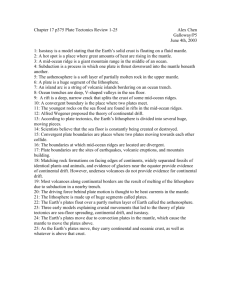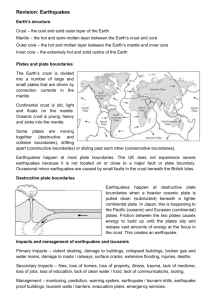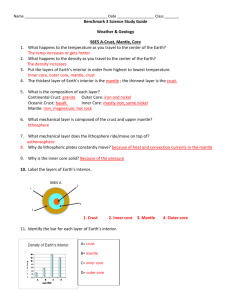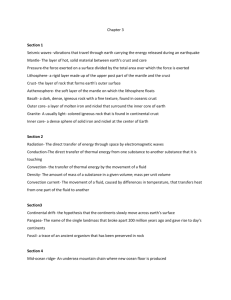Unit 1 Quiz
advertisement
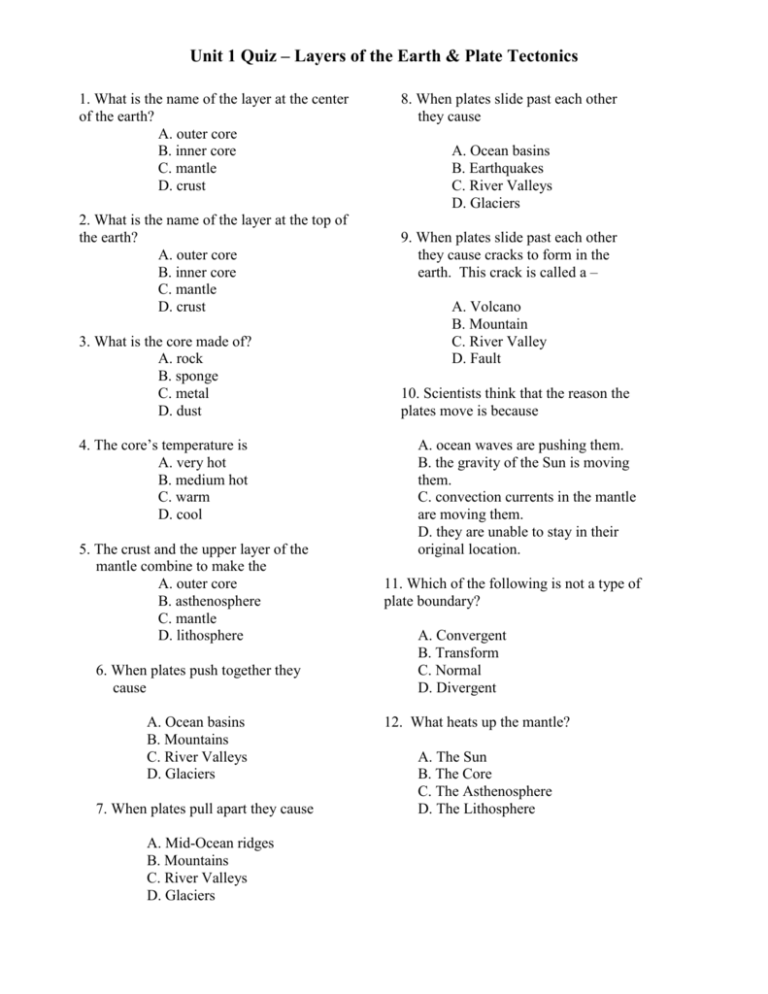
Unit 1 Quiz – Layers of the Earth & Plate Tectonics 1. What is the name of the layer at the center of the earth? A. outer core B. inner core C. mantle D. crust 2. What is the name of the layer at the top of the earth? A. outer core B. inner core C. mantle D. crust 3. What is the core made of? A. rock B. sponge C. metal D. dust 4. The core’s temperature is A. very hot B. medium hot C. warm D. cool 5. The crust and the upper layer of the mantle combine to make the A. outer core B. asthenosphere C. mantle D. lithosphere 6. When plates push together they cause A. Ocean basins B. Mountains C. River Valleys D. Glaciers 7. When plates pull apart they cause A. Mid-Ocean ridges B. Mountains C. River Valleys D. Glaciers 8. When plates slide past each other they cause A. Ocean basins B. Earthquakes C. River Valleys D. Glaciers 9. When plates slide past each other they cause cracks to form in the earth. This crack is called a – A. Volcano B. Mountain C. River Valley D. Fault 10. Scientists think that the reason the plates move is because A. ocean waves are pushing them. B. the gravity of the Sun is moving them. C. convection currents in the mantle are moving them. D. they are unable to stay in their original location. 11. Which of the following is not a type of plate boundary? A. Convergent B. Transform C. Normal D. Divergent 12. What heats up the mantle? A. The Sun B. The Core C. The Asthenosphere D. The Lithosphere Unit 1 Quiz – Layers of the Earth & Plate Tectonics 13. Why do cooler materials sink? 19. Where do most earthquakes occur? A. They are more dense than the surrounding area. B. They are less dense than the surrounding area. C. They are the same density as the surrounding area. D. Cooler material do not sink. A. in the Atlantic Ocean B. in the middle of a continent C. along the edge of a plate boundary D. where the Indian plate meets the Eurasian plate 20. What causes earthquakes? 14. What happens at a divergent boundary? A. Plates push together. B. Plate pull apart. C. Plates slide past each other. D. Plates do not move. 15. What types of crust occur on the earth? A. Olympic and continental B. Continental and oceanic C. Oceanic and corporeal D. Olympic and corporeal 16. What effects can be felt at transform boundaries? A. geysers B. hot springs C. earthquakes D. hurricanes 17. Where is new crust formed on the earth? A. along mid-ocean planes B. along mid-ocean ridges C. along all plate boundaries D. new crust is never formed 18. Where do volcanoes form? A. Where oceanic and oceanic crusts collide B. Where oceanic and continental crusts collide C. Where continental and continental crusts collide D. Only in California A. movement along a fault B. a tsunami C. steping on a fault D. scientists don’t know 21. What evidence do scientists look for to determine the location of a plate boundary? A. lots of rocks B. no rocks C. faults and volcanoes D. lots of people 22. Where does magma come from? A. lithosphere B. mantle C. core D. sun 23. What type of damage will an earthquake NOT cause? A. cracks in the earth B. the movement of roads and rivers C. wind damage to houses D. collapsed bridges Unit 1 Quiz – Layers of the Earth & Plate Tectonics 24. Label any two of the tectonic plates in the map above. 25. Which continent is found where 0°latitude meets 0° longitude? __________________________ 26. Which tectonic plate has very little land mass on it? __________________________ BONUS QUESTION What part of the EDP requires the engineer to ask themselves two questions: What do I know? And What do I need to know? _______________________________



